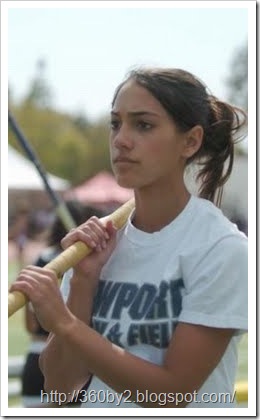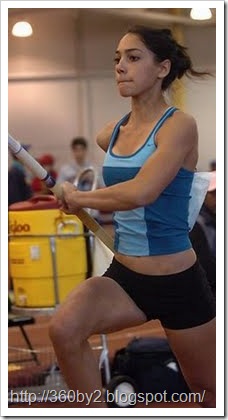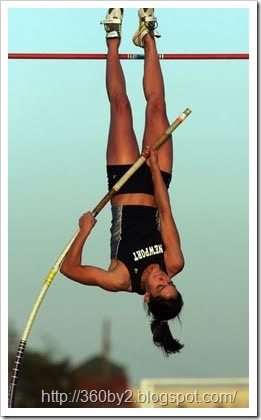 In the sport of cricket, the Duckworth-Lewis method (D/L method) is a mathematical way to calculate the target score for the team batting second in a one-day cricket or Twenty-20 cricket match interrupted by weather or other circumstance. It is generally accepted to be a fair and accurate method of setting a target score, but as it attempts to predict what would have happened had the game come to its natural conclusion, it generates some controversy. The D/L method was devised by two English statisticians, Frank Duckworth and Tony Lewis.
In the sport of cricket, the Duckworth-Lewis method (D/L method) is a mathematical way to calculate the target score for the team batting second in a one-day cricket or Twenty-20 cricket match interrupted by weather or other circumstance. It is generally accepted to be a fair and accurate method of setting a target score, but as it attempts to predict what would have happened had the game come to its natural conclusion, it generates some controversy. The D/L method was devised by two English statisticians, Frank Duckworth and Tony Lewis.
A simple example of the D/L method being applied was the first One Day International (ODI) between India and Pakistan in their 2006 ODI series. India batted first, and were all out in the 49th over for 328. Pakistan, batting second, were 7 wickets down for 311 when bad light stopped play after the 47th over.
In this example, Pakistan's target had the match continued was 18 runs in as many balls, with three wickets in hand. Considering the overall scoring rate throughout the match, this is a target most teams would be favoured to achieve. And indeed, application of the D/L method resulted in a target score of 304 at the end of the 47th over, with the officially listed result as "Pakistan won by 7 runs (D/L Method)".
The D/L method of resetting targets in rain-affected one-day cricket matches has now been in use for well over two years and has been adopted for use in most test playing countries of the world. And it is the 'rain-rule' in use for the 1999 World Cup competition played in May and June and hosted by the England & Wales Cricket Board.
The method is the invention of Frank Duckworth and Tony Lewis. Frank is a consultant statistician and editor of the Royal Statistical Society's monthly news magazine, RSS NEWS. Tony is a lecturer in mathematical subjects in the Faculty of Computer Studies and Mathematics at the University of the West of England, Bristol and chairman of the Western Branch of the Operational Research Society
The method that they have invented is simple to apply provided one is prepared to take a few minutes to understand its logic. The calculations can easily be performed using nothing more than a single table of numbers and a pocket calculator although a purpose built computer program is available to undertake the calculations accurately and quickly in match situations (see further information on this below). With a little practice, however, there is no reason why anyone should not be able to calculate the revised target and in quick time. The authors firmly believe that the method is simple enough for it to be adopted for use at all levels of limited-overs cricket. This article provides a summary of the way the method works.
Basis of the method
The D/L method works using the notion that teams have two resources with which to make as many runs as they can - these are the number of overs they have still to receive and the number of wickets they have in hand. From any stage in their innings, their further run-scoring capability depends on both these two resources in combination. The table gives the percentage of these combined resources that remain for any number of overs left and wickets lost. An extract from the table is given in Table 1. Information is provided later on how the full table can be obtained, including the ball-by-ball version which is used when stoppages occur mid-over.
When a match is shortened after it has begun, the resources of one or both teams are depleted and the two teams usually have different amounts of resource for their innings. In this case a revised target must be set. The D/L method does this in accordance with the relative resources available to the two teams. If stoppages cause the team batting second (referred to here as Team 2) to have less resources available, as is more often than not the case, then their target will be revised downwards. If, on the other hand, as often happens when Team 1's innings has been interrupted, the stoppages usually result in Team 2 having more resources available and then their target is revised upwards to correct for the extra resources they have at their disposal.
Table 1: Extract from the table of resource percentages remaining
Wickets lost
Ovleft 0 2 5 7 9
50 100. 83.8 49.5 26.5 7.6
40 90.3 77.6 48.3 26.4 7.6
30 77.1 68.2 45.7 26.2 7.6
25 68.7 61.8 43.4 25.9 7.6
20 58.9 54.0 40.0 25.2 7.6
10 34.1 32.5 27.5 20.6 7.5
5 18.4 17.9 16.4 14.0 7.0
Reading the table
The single table applies to all lengths of one-day matches from 50 overs-per-side downwards. Because this length of match is by far the most common, the resources listed in the table are expressed as percentages of those available at the start of a 50-over innings. Thus when there are 50 overs still to be received and no wickets have been lost, the resource percentage available is 100%. A 40-over innings starts with a resource percentage of 90.3% relative to a 50 over innings. An innings shortened to 25-overs before it starts commences with a resource percentage of 68.7% relative to 50-over innings. (Although such innings have only half the overs of a 50-over innings they have all 10 wickets and so have much more than half the resources.)
In order to determine the correct resource percentage the batting side has remaining at any stage of its innings, the number of overs left must be identified. This number of overs left, in conjunction with the number of wickets lost, is then used to read the resource percentage remaining from the table.
For example, suppose that after 20 out of 50 overs a team have lost 2 wickets. They have 30 overs left. From the table you will see that the resource percentage remaining is 68.2%.
Suppose now that there is an interruption in play and 10 overs are lost from the innings. When play can resume there are only 20 overs left but there are still, of course, 2 wickets down, and the table now tells us that the resource percentage remaining is 54.0%. Thus the shortening of the innings has caused the team to lose a resource percentage of 68.2 - 54.0 = 14.2%.
Having started with a resource percentage of 100% and lost 14.2%, then if they complete their innings with no further loss of overs, they will have had a resource percentage available for their innings of 100 - 14.2 = 85.8%.
Applying the D/L method
The procedure for setting a revised target, which is the same for any number of stoppages at any stage of the match, is as follows.
1. For each team's innings
(a) from the table note the resource percentage the team had available at the start of their innings;
(b) using the table, calculate the resource percentage lost by each interruption;
(c) hence calculate the resource percentage available.
2. If Team 2 have less resources available than Team 1, then calculate the ratio of the resources available to the two teams. Team 2's revised target is obtained by scaling down Team 1's score by this ratio. The figure so obtained is rounded down to the next whole number to give the score needed for a tie. The target is one more run than this. The procedure by which a tie is always possible is a consequence of a change in playing conditions introduced internationally from April 1999.
3. If Team 2 have more resources available than Team 1, then calculate the amount by which Team 2's resource percentage exceeds Team 1's. Work out this excess as a percentage of 225 [the average 50-over score in 'first class' matches and one-day internationals (ODIs)]. Rounding this down to the next whole number gives the extra runs to add on to Team 1's score to give the score to tie. Adding one run gives Team 2's target.







































































